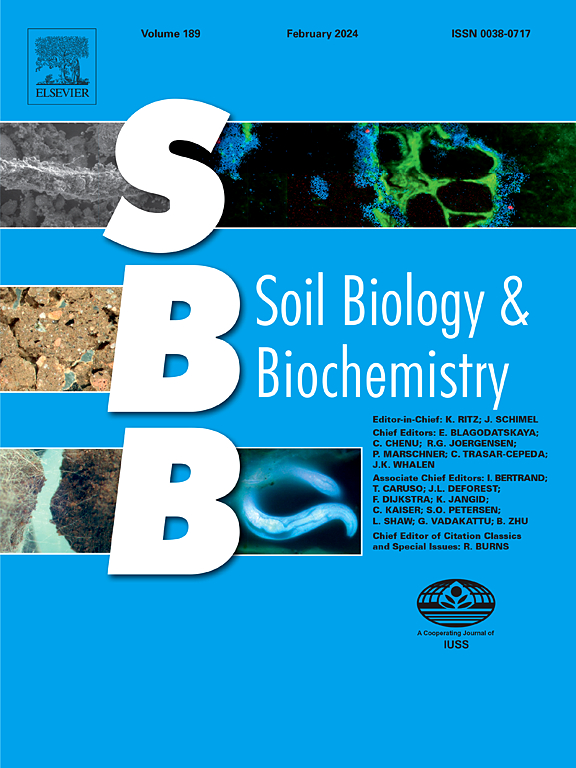Trophic interactions and microbial-derived carbon in porosphere of arable fields
IF 9.8
1区 农林科学
Q1 SOIL SCIENCE
引用次数: 0
Abstract
Soil physical properties, such as porosity, are recognized to play an important role in the formation of soil organism communities and may regulate carbon sequestration in the soil ecosystem. However, despite their eminent importance, the relation between the abundance of soil animals, microbial necromass and pore space has been rarely demonstrated empirically. In this study, soil visible macroporosity (measured using X-ray computed tomography), microbial necromass (a pool of soil organic carbon), and densities of nematode groups were measured in the topsoil layer at a depth of 10 cm in four arable fields in southern Finland (clay and loam soils). Bacterial necromass was positively correlated with visible macroporosity smaller than 428 μm in size. Fungal necromass was marginally correlated (p=0.059) with pores < 233 μm in size. The abundance of bacterial feeding nematodes (and unknown juveniles) scaled positively with microbial necromasses, visible macropores smaller than 700 μm and the total visible macroporosity. The abundance of other feeding groups was independent of soil visible macroporosity. However, trophic interactions between feeding groups of nematodes appeared to be weak in this soil layer. Results indicate strong bottom-up regulation between microbes and microbial feeding nematodes. Microbial necromass, as an important organic fraction in soil, was clearly related to small soil macropores (< 428 μm).These findings provide novel insights into how soil architecture, particularly macroporosity below 700 μm, influences the spatial ecology of soil organisms — an aspect that has received limited attention in boreal agroecosystems.农田孔隙圈营养相互作用与微生物碳源
土壤孔隙度等土壤物理特性在土壤生物群落的形成中发挥着重要作用,并可能调节土壤生态系统中的碳固存。然而,尽管它们非常重要,土壤动物丰度、微生物坏死团和孔隙空间之间的关系却很少得到实证证明。在这项研究中,在芬兰南部的四个耕地(粘土和壤土)的表层土壤中,测量了土壤可见宏观孔隙度(使用x射线计算机断层扫描测量)、微生物坏死块(土壤有机碳池)和线虫群的密度。细菌坏死团与小于428 μm的可见大孔隙呈正相关。真菌坏死块与气孔<呈边际相关(p=0.059);尺寸为233 μm。细菌取食线虫(和未知幼虫)的丰度与微生物坏死团、小于700 μm的可见大孔和总可见大孔呈正相关。其他摄食组的丰度与土壤可见宏观孔隙度无关。然而,在该土层中,线虫摄食群之间的营养相互作用似乎很弱。结果表明,微生物和以微生物为食的线虫之间有很强的自下而上的调节作用。微生物坏死块作为土壤中重要的有机组分,与土壤小孔隙(<;428μm)。这些发现为土壤结构,特别是700 μm以下的宏观孔隙度如何影响土壤生物的空间生态提供了新的见解-这是北方农业生态系统中受到有限关注的一个方面。
本文章由计算机程序翻译,如有差异,请以英文原文为准。
求助全文
约1分钟内获得全文
求助全文
来源期刊

Soil Biology & Biochemistry
农林科学-土壤科学
CiteScore
16.90
自引率
9.30%
发文量
312
审稿时长
49 days
期刊介绍:
Soil Biology & Biochemistry publishes original research articles of international significance focusing on biological processes in soil and their applications to soil and environmental quality. Major topics include the ecology and biochemical processes of soil organisms, their effects on the environment, and interactions with plants. The journal also welcomes state-of-the-art reviews and discussions on contemporary research in soil biology and biochemistry.
 求助内容:
求助内容: 应助结果提醒方式:
应助结果提醒方式:


